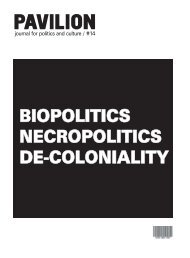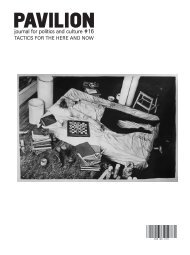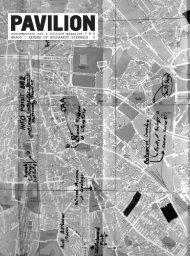PAVILION
PAVILION
PAVILION
- No tags were found...
You also want an ePaper? Increase the reach of your titles
YUMPU automatically turns print PDFs into web optimized ePapers that Google loves.
formed political party claiming continuity,<br />
via its leaders Corneliu Coposu and Ion<br />
Diaconecu, with the pre-war National<br />
Peasant Party, organized a meeting of<br />
protest “with the intention of deterring<br />
Iliescu and other former communist leaders<br />
from running in the May 20 election”<br />
(Osmani 1997: 3). However, the demonstration<br />
did not terminate at the end of the<br />
day: protesters blocked University<br />
Square with the intention of continuing<br />
the struggle against communism that had<br />
started with the 1989 Revolution. It is no<br />
coincidence that the date chosen for the<br />
protest by the NPP was April 22, a day<br />
exactly four months after the 1989<br />
Revolution. Hence, those who conceived<br />
the Proclamation of Timişoara, as well as<br />
the NPP, became the first actors of the<br />
University Square Phenomenon, while<br />
the actual Proclamation articulated a new<br />
political category whose pillar was “antineo-communism.”<br />
These elements are<br />
best understood in the context of repertoires<br />
of contention, where “previously<br />
created performances” (Tilly 2002: 118)<br />
are borrowed for new purposes. In the<br />
case of University Square, the repertoire<br />
was only four months old and the slogans<br />
that predominated in University Square<br />
were, as they had been four months earlier,<br />
“Down with the Communists!” to<br />
which was added “Down with the Neo-<br />
Communists!”<br />
Two days into the demonstration, on April<br />
25, the protesters abandoned the NPP<br />
identity in favour of a new “University<br />
Square identity” that was to extend from<br />
Bucharest throughout the country, and<br />
which shared the NPP’s opposition to<br />
communism, but did not include a genuine<br />
political platform for winning the May<br />
election. Unlike the NPP, the University<br />
Square events were not an attempt to win<br />
the election, only to deter FNS from participating<br />
in it. In this manner, the protesters<br />
could bestow upon themselves a<br />
moral role unfettered by long-term electoral<br />
motives. The University Square<br />
events also brought about unintended<br />
consequences by moving beyond the<br />
intent of the NPP, by gaining its own identity,<br />
and by abandoning political ties with<br />
the party that had organized the meeting<br />
in the first place. Furthermore, the issue<br />
of the May 20 election was pushed to the<br />
periphery of their protest while the<br />
Proclamation of Timişoara and the anticommunist<br />
agenda moved to the forefront.<br />
This switch in agenda could have<br />
aided the University Square identity formation.<br />
This becomes particularly clear when one<br />
compares the University Square<br />
Phenomenon with the 1996-97 Serbian<br />
student movement, as the two protest<br />
movements share some basic features.<br />
Yet, the raison d’être for the Serbian<br />
protest was and remained narrow in<br />
scope, as it focused on the recognition of<br />
the November 17 municipal elections, in<br />
which the Zajedno opposition alliance<br />
won Belgrade and other major cities. As a<br />
result, Slobodan Milošević was able to<br />
dismantle the fragile anti-Milošević coalition<br />
and put an end to the student protest<br />
by simply giving into the opposition’s<br />
demands (Thompson and Kuntz 2004).<br />
Compared to the members of the 1996-<br />
97 Serbian student movement, the<br />
University Square protesters were less<br />
pragmatic; their demands reached<br />
beyond short-term political goals and<br />
aimed at the overly naïve but morally<br />
inspiring process of decommunization<br />
and “trial of communism.” Thus, the<br />
weeks from April 22 to May 20 were sufficient<br />
to allow for the emergence of this<br />
new political identity, whose main pillar<br />
was the struggle against communism and<br />
contoured around the “categorically<br />
against communism” stance of the<br />
Proclamation of Timişoara.<br />
Another element that contributed to the<br />
consolidation of this new political identity<br />
came from the way in which the protesters<br />
interpreted the 1989 Revolution.<br />
Essentially, the protesters in University<br />
Square were challenging the victory that<br />
the FNS had proclaimed. Protesters<br />
began referring to the University Square<br />
Phenomenon as the continuation of the<br />
1989 December Revolution. It was this<br />
belief that created for them a “fortifying<br />
myth.” Part of the motivation behind this<br />
interpretation came directly from the<br />
Proclamation of Timişoara, which ends<br />
with the statement: “We, the authors of<br />
this Proclamation, participants at the<br />
events from December 16-22, do not<br />
consider the Revolution finished. We will<br />
continue it firmly. After we faced and triumphed,<br />
without anyone’s help, in overthrowing<br />
one of the most powerful and<br />
repressive systems in the world, nobody<br />
and nothing can intimidate us.”<br />
Furthermore, signboards reading “PCR =<br />
FSN” (Romanian Communist Party =<br />
Front for National Salvation) appeared in<br />
University Square, further adding to the<br />
sense of continuity between the 1989<br />
Revolution and the current protest.<br />
Hence, exactly four months after the<br />
Revolution, the people of Bucharest were<br />
once again shouting: “Down with the<br />
Communists,” asserting in University<br />
Square that, for them, the 1989<br />
Revolution was continuing and that the<br />
battle against the communist regime was<br />
still to be won.<br />
The early days of the University Square<br />
movement included powerful elements of<br />
contention. Most important among these<br />
are the repertoires of contention and the<br />
emergence of a new political identity that<br />
benefited from the way the protesters<br />
depicted the Revolution, allowing political<br />
legitimacy to pass from the 1989<br />
Revolution to the University Square. The<br />
University Square movement formed its<br />
new political identity by retaining the<br />
same slogans and the same goals of<br />
anti-communism from the 1989<br />
Revolution, and by applying them, not to<br />
the former Communist Party, but to the<br />
newly formed provisional government,<br />
FNS. The demonstration organized by<br />
the NPP broke allegiance with the party<br />
only two days later and became an<br />
episode of mass protest with its own<br />
identity and remained this way for the following<br />
six weeks. In more theoretical<br />
terms, the action of breaking allegiance<br />
with the NPP marks an “object shift,”<br />
changing the focus of the protest from the<br />
May 20 elections to the anti-neo-communist<br />
and anti-FNS. Those same elements<br />
of the repertoire of contention and political<br />
identity are also present in the subsequent<br />
days of the University Square but<br />
in a slightly different form as the political<br />
identity of the University Square gained a<br />
bolder contour.<br />
Development: What was the University<br />
Square Phenomenon?<br />
Two days into the University Square<br />
Phenomenon, the protesters declared<br />
themselves to be peaceful, multicultural<br />
(they included Hungarians and other eth-<br />
[30]<br />
[31]








